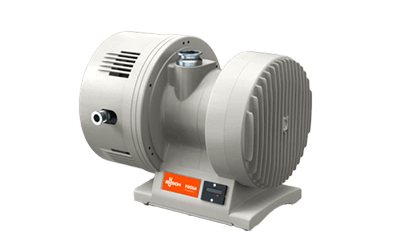What Is a Scroll Pump?

A scroll pump is one of a variety of dry vacuum pumps that achieve a vacuum without the use of oil. It is a vacuum pump with a mechanism that compresses and expels gas by rotating two “scrolls,” a spiral-shaped structure inside an enclosure.
Scroll pumps are vacuum pumps with a structure that produces little vibration and noise and is easy to miniaturize. Also, unlike ordinary rotary pumps, they do not discharge oil mist, making them suitable for use in clean environments.
For this reason, they are used in scientific analysis equipment, vacuum drying and adsorption equipment, etc.
Applications of Scroll Pumps
Scroll pumps are characterized by their small size, low vibration, and low noise level. Furthermore, they do not emit oil mist, making them suitable for use in clean environments.
- Transmission electron microscopes
- Vacuum drying equipment
- Vacuum adsorption and deposition equipment
- Vacuum heat treatment furnaces
- Various other scientific analysis equipment
- Glove boxes
- LED light manufacturing
- Freeze-dried product manufacturing
- Crystal pulling
- Dryers
In addition, scroll pumps are also used to achieve ultra-high vacuum in equipment, and are used for roughing before the operation of turbomolecular pumps.
Principle of Scroll Pumps
The principle of the scroll pump is that two scrolls rotate to expel air. Housed within the housing of the scroll pump are two impellers, called scrolls, with a spiral structure.
Since these two scrolls are installed with their centers of rotation slightly offset from each other, they rub against each other as they rotate. The gas trapped in the small chamber is compressed as it moves and is finally discharged out of the pump.
Structure of a Scroll Pump
The structure of a scroll pump consists of two scrolls with slightly offset centers of rotation. The scrolls are shaped like an involute curve; the trajectory drawn by the tip of a thread wound around a cylinder when it is unraveled while being pulled to keep it from loosening.
Air is expelled out of the pump by the movement of the small chambers created by these two scroll pumps.
Features of Scroll Pumps
The first characteristic of scroll pumps is they are completely oil-free. In oil-rotating pumps, known as rotary pumps, oil is used to lubricate and cool the mechanical parts that discharge air and to ensure airtightness, but the oil may evaporate and be contained in the exhaust.
Scroll pumps do not use oil in their mechanical parts and therefore do not contain oil in the exhaust air. Because they provide a clean vacuum environment, they are used in a wide variety of analytical instruments. Other features include a compact pump body and low noise and vibration.
Other Information on Scroll Pumps
1. Capabilities of Scroll Pumps
Scroll pumps are a type of vacuum pump, but they vary in the degree of vacuum they can achieve. The word “vacuum” may conjure up images of a state in which there is no air at all, but this is not necessarily a state in which there is nothing.
On the ground where we live, atmospheric pressure is one atmosphere, which corresponds to 133.3 Pa. The vacuum that can be created by a scroll pump is about 1 Pa.
Furthermore, when a high vacuum is required, the pump is used in combination with other pumps. In analytical instruments that require a high vacuum, scroll pumps are combined with turbomolecular pumps and other pumps to achieve a high vacuum in a short period.
2. Disadvantages of Scroll Pumps
Scroll pump pumps require periodic maintenance, which is relatively time-consuming, because the seals on the scroll wear out after prolonged use. In addition, conventional pumps cannot exhaust gases such as water vapor due to limitations in the material of the scroll pump, but recently pumps equipped with bearing shields and gas ballast have been developed.
This has made it possible to construct vacuum lines without the need for trap systems or oil mist eliminators.